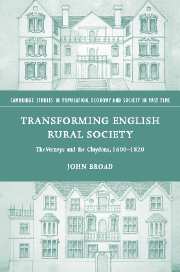Book contents
- Frontmatter
- Contents
- List of figures
- List of tables
- Preface
- Acknowledgements
- Note on editorial practice
- List of abbreviations
- 1 Introduction
- Part I Re-establishing a gentry family 1600–1657
- Part II The shaping of family and village 1657–1740
- Part III The great estate and estate communities c. 1700–1820
- 8 The rise and fall of Verney fortunes in the eighteenth century 1740–1820
- 9 Transforming the Claydons in the eighteenth century
- 10 Conclusion
- Appendix A Sir Ralph Verney's confessional letter of 1650
- Appendix B The genealogy of the Verney family
- Bibliography
- Index
9 - Transforming the Claydons in the eighteenth century
Published online by Cambridge University Press: 03 July 2009
- Frontmatter
- Contents
- List of figures
- List of tables
- Preface
- Acknowledgements
- Note on editorial practice
- List of abbreviations
- 1 Introduction
- Part I Re-establishing a gentry family 1600–1657
- Part II The shaping of family and village 1657–1740
- Part III The great estate and estate communities c. 1700–1820
- 8 The rise and fall of Verney fortunes in the eighteenth century 1740–1820
- 9 Transforming the Claydons in the eighteenth century
- 10 Conclusion
- Appendix A Sir Ralph Verney's confessional letter of 1650
- Appendix B The genealogy of the Verney family
- Bibliography
- Index
Summary
As the Verneys expanded their estates during the eighteenth century, they extended their social and economic control beyond Middle Claydon to the adjoining parishes of East and Steeple Claydon. This chapter examines the extent to which changes in Middle Claydon in the period 1660 to 1740 were extended elsewhere in the Claydons during the eighteenth century. After 1730 the Claydon correspondence becomes less compendious, and after 1752 fragmentary, dominated by material relating to court cases about the second earl's debts and business affairs. Material about the running of the Claydon estates is episodic, with no long runs of letters, so this analysis is more dependent on conventional sources about rents, farm sizes, and tenants, the structure of landholding and tenancy, and rich occupational data, linked where possible to parish reconstitution.
These changes after 1750 mirror a shift in the second Earl Verney's concerns and priorities. His life became London-based and he spent much time on politics and business schemes. Although he rebuilt Claydon, it is doubtful if he lived there for long periods, particularly between 1760 and 1780, when he used Biddlesden House near Stowe and Buckingham as his Buckinghamshire residence. He spent more time in London, following the pattern set by his father and mother after 1721 when they established a permanent residence in Little Chelsea, rather than using the central London lodgings as had been customary for Sir Ralph and Sir John Verney.
- Type
- Chapter
- Information
- Transforming English Rural SocietyThe Verneys and the Claydons, 1600–1820, pp. 228 - 263Publisher: Cambridge University PressPrint publication year: 2004

